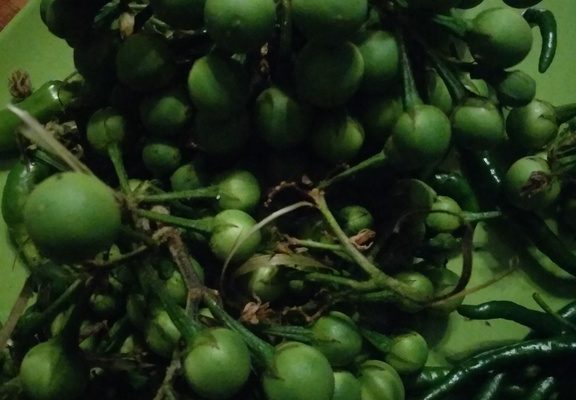Scientific Name: Solanum torvum
Bahasa Indonesian: Takokak
Batak: Rimbang
Basic Information:
Solanum torvum is a bushy, erect and spiny perennial plant used horticulturally as a rootstock for eggplant. Grafted plants are very vigorous and tolerate diseases affecting the root system, thus allowing the crop to continue for a second year.
It is also known as turkey berry,[2] prickly nightshade, shoo-shoo bush, wild eggplant, pea eggplant, pea aubergine, kantɔsi, konsusua or abeduru (Ghana), kittily (Liberia), susumber (Jamaica), boo, terongan, tekokak, rimbang, berenjena cimarrona, berenjena de gallina, berenjena silvestre, tabacón, pendejera, tomatillo, bâtard balengène, zamorette, friega-platos, kudanekayi (Kannada: ಕುದನೆಕಾಯಿ), (Gujarati: ગુજરાતી)sundaikkai [3](Tamil: சுண்டைக்காய்),[4] (Malayalam: ചുണ്ട ), thibbatu (Sinhala: තිබ්බටු), makhuea phuang (Thai: มะเขือพวง), suzume nasu (Japan: 雀茄子), jurubeba (Brazilian Portuguese), Ka Ran Sate Kay Thi (Myanmar-Arakan), and many other names (Howard 1989, Little and others 1974, Pacific Island Ecosystems at Risk 2001).
Health Benefits:
Solanum torvum Swartz (family: Solanaceae) is commonly known as turkey berry. This plant is found in tropical Africa, Asia and South America. S. torvum, is an important medicinal plant in tropical and subtropical countries is widely used like food and in folk medicine around the world. This aims a comprehensive of the chemical constituents, pharmacological, and clinical uses. A number of metabolites are in good yield and some have been shown to possess useful biological activities belonging mainly to steroid glycosides and saponins, flavonoid, vitamin B group, vitamin C, iron salts and steroidal alkaloids. Extracts and metabolites of this plant, particularly those from leaves and fruits possess useful pharmacological activities. A survey of the literature shows S. torvum is mainly used for the treatment of fever, wounds, tooth decay, reproductive problems and arterial hypertension. Many pharmacological studies have demonstrated the ability of this plant to exhibit Anti-oxidant activity, cardiovascular, immunomodulatory and nephroprotective activity supporting its traditional uses. This review attempts to highlight the available literature on S. torvum with respect to ethnobotany, chemical constituents and summary of various pharmacological activities.
Fun Facts:I
- If you eat the fruit raw, the first one is bitter. You wait for 2 minutes, then you eat the next one, and it is sweet.
- If you open your eyes and you walk around in South East Asia in the nature, everywhere you will find this plant.
- You just can eat it on the way. A perfect small snack all the time. Just pick it and eat it.
Sources:
https://en.wikipedia.org/wiki/Solanum_torvum

